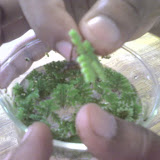Hydrosere
Hydrosere or Hydrarch succession occurs in a pond and its community are converted into a land community.
Characteristics of Hydrosere:
- In the initial stage, phytoplankton(cyanobacteria), green algae (Spirogyra,Oedogonium) are the pioneer colonizers.
- They are consumed by zooplankton (protozoans asAmoeba, Euglena, Paramecium etc), fish such as sun fish, blue gill fish etc.
- Gradually these organisms die and increase the content of dead organic matter in the pond.
- This is then utilized by bacteria and fungi, and minerals are released after decomposition.
- Nutrient rich mud supports rooted hydrophytes growth as Elodea, Hydrilla, Ceratophyllum etc in the shallow water zone.
- This submerged stage is also inhabited by animals such as may flies. Dragon flies etc and Crustaceans asDaphnia, Cypris, Cyclops etc.
- The hydrophytes die and decomposed by micro organisms and thus release nutrients.
- Due to silting, water depth is reduced and at the margin of pond grow rooted floating vegetation.
- Example- Nelumbo nucifera, Monochoria, Trapa etc.
- In floating stage faunal living space is increased and diversified. Example- frogs, salamander, hydra, diving beetles etc inhabit such conditions. Some turtles and snake also invade the pond.
- Gradually, the water depth decreases due to water evaporation and organic matter decomposition.
- Free floating plants as Lemna, Azolla, Pistia, Spirodella, Wolffia etc increase in number as availability of high nutrient is there.
- When these die, they build up the pond ecosystem, resulting in further build up of the substratum.
- Pond becomes a Swampy ecosystem.
- The reed swamp species, such as Scirpus, Typha or Phragmites and sedges as Juncus, Carex, Cyperus etc invade the pond and gradually replaced by mesic communities.
- Gradually, land plants as shrubs (Salix and Cornus) and trees (Almus, Populus) invade ending in the climax community as deciduous forest.
- The aquatic fauna also changes and ultimately gets replaced by land animals.
Xerosere
Xerosere or Xerarch succession begins on exposed parent rocks (lithosere) or dry sand (psammosere).
A lithosere involves following stages-
Xerosere or Xerarch succession begins on exposed parent rocks (lithosere) or dry sand (psammosere).
A lithosere involves following stages-
crustose lichen stage (pioneers) – foliose lichen stage – moss stage – herbs stage – shrub stage – forest stage (climax stage).
Characteristics of Xerosere:
Characteristics of Xerosere:
- Thus, pioneer plants are lichens, mosses and Selaginella that help in soil formation.
- In due course of time, annuals and herbaceous vegetation grow on the soils deposited on rocks.
- Lithosere also involves successive changes in animal life.
- Pioneer stages in animals are few species of mites, spiders and ants which are exposed to harsh temperatures.
- During moss stage, many new species of mites, spiders, springtails invade the community.
- Herb stage is invaded by nematodes, mites and various insect larvae.
- Great modifications occur in the fauna of shrub and forest stage. Numerous kinds of animals as snails, wire worm, millipede, mites, ants and amphibians such as frogs, salamander occur. Reptiles which occur there are skinks, turtles and other lizards. Birds such as grouse and flycatcher and mammals as shrews, mouse, mole, squirrels, fox and chipmunk occur.
Websites:





